The Effect of Petroleum-Derived Substances and Their Bioremediation on Soil Enzymatic Activity and Soil Invertebrates
Abstract
1. Introduction
2. Materials and Methods
2.1. Experimental Setup
2.2. Soil Enzymatic Activity
- Ah—soil enzymatic activity in the contaminated site,
- Ac—soil enzymatic activity in the control site.
2.3. Soil Invertebrates
2.4. Statistical Analysis
3. Results
3.1. Selected Soil Parameters: Hydrocarbon Content, pH, and Ctotal Content
3.2. Soil Enzyme Activity
3.2.1. Alkaline Phosphatase, Acid Phosphatase, Dehydrogenase, and Urease
3.2.2. ACR Indicator
3.3. Soil Invertebrates
3.3.1. Total Number of Soil Invertebrates Four- and Five-Years Post Contamination
3.3.2. Occurrence of Enchytraeidae, Collembola, Nematoda, and Arachnida
3.3.3. Collembola Families
3.4. The Relationships between PDSs, Bioremediation, Soil Enzyme Activity, and Soil Fauna Occurrence
4. Discussion
4.1. Hydrocarbons Degradation
4.2. The Effect of PDSs on Alkaline Phosphatase, Acid Phosphatase, Dehydrogenase, and Urease
4.3. The Effect of ZB-01 on Alkaline Phosphatase, Acid Phosphatase, Dehydrogenase, and Urease
4.4. The Effect of PDSs on Soil Invertebrates
4.5. The Effect of ZB-01 on Soil Invertebrates
5. Conclusions
- PDSs even after the lapse of five years from the moment of contamination significantly modified the activity of soil enzymes analyzed; however, this effect was often varied, depending on the pollutant, enzyme, and time elapsed after soil contamination. Dehydrogenase seems to be a good indicator of soil contamination with PDSs, particularly DF.
- Of the analyzed PDSs, oils (DF and EO) restricted the occurrence of soil invertebrates, particularly Collembola from the families Hypogastruidae, Isotomidae, and Entomobryidae, even after four and five years of contamination. This proves the usefulness of these groups of organisms in assessing soil pollution with PDSs and in monitoring the progress of bioremediation.
- The effect of bioremediation using ZB-01 biopreparation on the activity of selected enzymes was variable and depended on the type of contaminant, the type of enzyme analyzed, and the time elapsed after contamination and the use of the preparation. The effect of the application of the biopreparation on the occurrence of soil invertebrates was usually beneficial, which was particularly evident for DF-contaminated soil.
Author Contributions
Funding
Institutional Review Board Statement
Informed Consent Statement
Data Availability Statement
Conflicts of Interest
References
- Margesin, R. Determination of enzyme activities in contaminated soil. In Monitoring and Assesing Soil Bioremediation. Manuals of Soils Analysis; Margesin, R., Schinner, F., Eds.; Springer: Berlin, Germany, 2005. [Google Scholar]
- Alrumman, S.A.; Standing, D.B.; Paton, G.I. Effects of hydrocarbon contamination on soil microbial community and enzyme activity. J. King Saud. Univ. Sci. 2015, 27, 31–41. [Google Scholar] [CrossRef]
- Caravaca, F.; Rodán, A. Assessing changes in physical and biological properties in soil contaminated by oil sludges under semiarid Mediterranean conditions. Geoderma 2013, 117, 53–61. [Google Scholar] [CrossRef]
- Rusin, M.; Gospodarek, J.; Nadgórska–Socha, A.; Barczyk, G. Effect of petroleum–derived substances on life history traits of black bean aphid (Aphis fabae Scop.) and on the growth and chemical composition of broad bean. Ecotoxicology 2017, 26, 308–319. [Google Scholar] [CrossRef] [PubMed]
- Rusin, M.; Gospodarek, J.; Nadgórska–Socha, A.; Barczyk, G.; Boligłowa, E.; Dabioch, M. Effect of petroleum–derived substances on life history traits of bird cherry–Oat aphid (Rhopalosiphum padi L.) and on the growth and chemical composition of winter wheat. Environ. Sci. Pollut. Res. 2018, 25, 27000–27012. [Google Scholar] [CrossRef]
- Rusin, M.; Gospodarek, J.; Barczyk, G.; Nadgórska–Socha, A. Antioxidant responses of Triticum aestivum plants to petroleum-derived substances. Ecotoxicology 2018, 27, 1352–1367. [Google Scholar] [CrossRef]
- Ramadass, K.; Megharaj, M.; Venkateswarlu, K.; Naidu, R. Ecotoxicity of measured concentrations of soil-applied diesel: Effects on earthworm survival, dehydrogenase, urease and nitrification activities. Appl. Soil Ecol. 2017, 119, 1–7. [Google Scholar] [CrossRef]
- Margesin, R.; Walder, G.; Schinner, F. The impact of hydrocarbon remediation (diesel oil and polycyclic aromatic hydrocarbons) on enzyme activities and microbial properties of soil. Acta Biotechnol. 2000, 20, 313–333. [Google Scholar] [CrossRef]
- Margesin, R.; Zimmerbauer, A.; Schinner, F. Monitoring of bioremediation by soil biological activities. Chemosphere 2000, 40, 339–346. [Google Scholar] [CrossRef]
- Hentati, O.; Lachhab, R.; Ayadi, M.; Ksibi, M. Toxicity assessment for petroleum-contaminated soil using terrestrial invertebrates and plant bioassays. Environ. Monit. Assess. 2013, 185, 2989–2998. [Google Scholar] [CrossRef]
- Najar-Rodriguez, A.J.; Lavidis, N.A.; Mensah, R.K.; Choy, P.T.; Walter, G.H. The toxicological effects of petroleum spray oils on insects–Evidence for an alternative mode of action and possible new control options. Food Chem. Toxicol. 2008, 46, 3003–3014. [Google Scholar] [CrossRef]
- Zhang, J.M.; Liu, F.; Huang, H.; Wang, R.J.; Xu, B.L. Occurrence, risk and influencing factors of polycyclic aromatic hydrocarbons in surface soils from a large-scale coal mine, Huainan, China. Ecotoxicol. Environ. Saf. 2020, 192, 110269. [Google Scholar] [CrossRef] [PubMed]
- Nadgórska-Socha, A.; Łukasik, I.; Ciepał, R.; Pomierny, S. The activity of selected enzymes in soil loaded with varied heavy metals level. Acta Agrophys. 2006, 8, 713–725. [Google Scholar]
- Fernández, D.A.; Roldán, A.; Azcón, R.; Caravaca, F.; Bååth, E. Effects of water stress, organic amendment and mycorrhizal inoculation on soil microbial community structure and activity during the establishment of two heavy metal-tolerant native plant species. Microb. Ecol. 2012, 63, 794–803. [Google Scholar] [CrossRef] [PubMed]
- Dindar, E.; Şağban, F.O.T.; Başkaya, H.S. Bioremediation of petroleum contaminated soil. J. Biol. Environ. Sci. 2013, 7, 39–47. [Google Scholar]
- Kaczyńska, G.; Borowik, A.; Wyszkowska, J. Soil dehydrogenases as an indicator of contamination of the environment with petroleum products. Water Air Soil Pollut. 2015, 226, 372. [Google Scholar] [CrossRef]
- Yang, Q.; Luo, K.; Li, X.M.; Wang, D.B.; Zheng, W.; Zeng, G.M.; Liu, J.J. Enhanced efficiency of biological excess sludge hydrolysis under anaerobic digestion by additional enzymes. Bioresour. Technol. 2010, 101, 2924–2930. [Google Scholar] [CrossRef]
- Sannino, F.; Gianfreda, L. Pesticide influence on soil enzymatic activities. Chemosphere 2001, 45, 417–425. [Google Scholar] [CrossRef]
- Markkola, A.M.; Tarvainen, O.; Ahonen-Jonnarth, U.; Strömer, R. Urban polluted forest soils induce elevated root peroxidase activity in Scots pine (Pinus sylvestris L.) seedlings. Environ. Pollut. 2002, 116, 273–278. [Google Scholar] [CrossRef]
- Barrutia, O.; Garbisu, C.; Epelde, L.; Sampedro, M.C.; Goicolea, M.A.; Becerril, J.M. Plant tolerance to diesel minimizes its impact on soil microbial characteristics during rhizoremediation of diesel-contaminated soils. Sci. Total Environ. 2011, 409, 4087–4093. [Google Scholar] [CrossRef]
- Schaefer, M. Earthworms in crude oil contaminated soils: Toxicity tests and effects on crude oil degradation. J. Contam. Soil Sed. Water 2001, 8, 35–37. [Google Scholar]
- Dorn, P.; Salanitro, J. Temporal ecological assesment of oil contaminated soils before and after bioremediation. Chemosphere 2000, 40, 419–426. [Google Scholar] [CrossRef]
- Tang, J.; Liste, H.; Alexander, M. Chemical assays of availability to earthworms of polycyclic aromatic hydrocarbons in soil. Chemosphere 2002, 48, 35–42. [Google Scholar] [CrossRef]
- Lu, L.; Wu, R.S.S. A field experimental study on recolonization and succession of macrobenthic infauna in defaunated sediment contaminated with petroleum hydrocarbons. Estuar. Coast. Shelf. Sci. 2006, 68, 627–634. [Google Scholar] [CrossRef]
- Gospodarek, J. Effect of oil derivative spill on epigeal mezofauna. Proc. Ecopole 2008, 2, 309–314. [Google Scholar]
- Gospodarek, J.; Kołoczek, H.; Petryszak, P.; Rusin, M. Effect of bioremediation of oil derivatives in soil on Pterostichus sp. (Coleoptera, Carabidae) occurrence. Ecol. Chem. Eng. A 2013, 20, 545–554. [Google Scholar]
- Gospodarek, J.; Petryszak, P.; Kołoczek, H.; Rusin, M. The effect of soil pollution with petroleum-derived substances on Porcellio scaber Latr. (Crustacea, Isopoda). Environ. Monit. Assess. 2019, 191, 38. [Google Scholar] [CrossRef]
- Al-Mutairi, N.; Bufarsan, A.; Al-Rukaibi, F. Ecorisk evaluation and treatability potential of soils contaminated with petroleum hydrocarbon-based fuels. Chemosphere 2008, 74, 142–148. [Google Scholar] [CrossRef]
- Gospodarek, J.; Petryszak, P.; Kołoczek, H. The effect of the bioremediation of soil contaminated with petroleum derivatives on the occurrence of epigeic and edaphic fauna. Biorem. J. 2016, 20, 38–53. [Google Scholar] [CrossRef]
- Blakely, J.K.; Neher, D.A.; Spongberg, A.L. Soil invertebrate and microbial communities and decomposition as indicators of polycyclic aromatic hydrocarbon contamination. Appl. Soil Ecol. 2002, 21, 71–88. [Google Scholar] [CrossRef]
- Brennan, A.; Fortune, T.; Bolger, T. Collembola abundances and assemblage structures in conventionally tilled and conservation tillage arable systems. Pedobiologia 2006, 50, 135–145. [Google Scholar] [CrossRef]
- Kireeva, N.A.; Khanislamova, G.M.; Tarasenko, E.M. Biological testing of oil–Polluted and reclaimed soils based on the survival of springtails (Collembola). Russ. J. Ecol. 2005, 36, 361–364. [Google Scholar] [CrossRef]
- Gworek, B.; Baczewska-Dąbrowska, A.H.; Kalinowski, R.; Górska, E.B.; Rekosz-Burlaga, H.; Gozdowski, D.; Olejniczak, I.; Graniewska, M.; Dmuchowski, W. Ecological risk assessment for land contaminated by petrochemical industry. PLoS ONE 2018, 13, e0204852. [Google Scholar] [CrossRef] [PubMed]
- Klimkowicz-Pawlas, A.; Maliszewska-Kordybach, B.; Smreczak, B. Triad-based screening risk assessment of the agricultural area exposed to the long-term PAHs contamination. Environ. Geochem. Health 2019, 41, 1369–1385. [Google Scholar] [CrossRef] [PubMed]
- Petryszak, P.; Kołoczek, H.; Kaszycki, P. Biological treatment of wastewaters generated by furniture industry. Part 1. Laboratory-scale process for biodegradation of recalcitrant xenobiotics. Ecol. Chem. Eng. A 2008, 15, 1129–1141. [Google Scholar]
- Rusin, M.; Gospodarek, J. The occurrence of springtails (Collembola) andspiders (Araneae) as an effectiveness indicator of bioremediation of soil contaminated by petroleum–derived substances. Int. J. Environ. Res. 2016, 10, 449–458. [Google Scholar]
- Gospodarek, J.; Rusin, M.; Nadgórska-Socha, A. The long-term effect of petroleum-derived substances and their bioremediation on the host plant (Vicia faba L.) and a herbivore (Sitona spp.). Agronomy 2020, 10, 1066. [Google Scholar] [CrossRef]
- Schinner, F.; Öhlinger, R.; Kandeler, E.; Margesin, R. (Eds.) Methods in Soil Biology; Springer: Berlin, Germany, 1995; p. 426. [Google Scholar]
- Wyczółkowski, A.I.; Dąbek-Szreniawska, M. Enzymy biorące udział w mineralizacji azotu organicznego. Acta Agrophys. 2005, 3, 37–61. [Google Scholar]
- Xian, Y.; Wanga, M.; Chena, W. Quantitative assessment on soil enzyme activities of heavy metal contaminated soils with various soil properties. Chemosphere 2015, 139, 604–608. [Google Scholar] [CrossRef]
- ISO 23611-2. Soil Quality–Sampling of Soil Invertebrates–Part 2: Sampling and Extraction of Micro-Arthropods (Collembola and Acarina); ISO: Geneva, Switzerland, 2006. [Google Scholar]
- Fjellberg, A. The Collembola of Fennoscandia and Denmark. Part I: Poduromorpha. Fauna Entomol. Scand. 1998, 35, 1–184. [Google Scholar]
- Fjellberg, A. The Collembola of Fennoscandia and Denmark. Part II: Entomobryomorpha and Symphypleona. Fauna Entomol. Scand. 2012, 42, 1–252. [Google Scholar]
- Ter Braak, C.J.F.; Šmilauer, P. CANOCO Reference Manual and User’s Guide to Canoco for Windows: Software for Canonical Community Ordination (Version 4.5); Microcomputer Power: Ithaca, NY, USA, 2002. [Google Scholar]
- Van Hamme, J.D.; Singh, A.; Ward, O.P. Recent advances in petroleum microbiology. Microbiol. Mol. Biol. Rev. 2003, 67, 503–549. [Google Scholar] [CrossRef] [PubMed]
- Dindar, E.; Topac Sagban, F.O.; Baskaya, H.S. Biodegradation of used engine oil in a wastewater sludge-amended agricultural soil. Turk. J. Agric. For. 2016, 40, 631–641. [Google Scholar] [CrossRef]
- Dindar, E.; Sagban, F.O.T.; Baskaya, H.S. Variations of soil enzyme activities in petroleum-hydrocarbon contaminated soil. Int. Biodeter. Biodegr. 2015, 105, 268–275. [Google Scholar] [CrossRef]
- Loehr, R.C.; McMillen, S.J.; Webster, T. Predictions of biotreatability and actual results: Soils with petroleum hydrocarbons. Pract. Period. Hazard. Toxic Radioact. Waste Manag. 2001, 5, 78–87. [Google Scholar] [CrossRef]
- Andreoni, V.; Cavalca, L.; Rao, M.A.; Nocerino, G.; Bernasconi, S.; Dell’Amico, E.; Combolo, M.; Gianfreda, L. Bacterial communities and enzyme activities of PAHs polluted soils. Chemosphere 2004, 57, 401–412. [Google Scholar] [CrossRef]
- Wyszkowska, J.; Kucharski, J. Biochemical properties of soil contaminated by petrol. Pol. J. Environ. Stud. 2000, 9, 479–485. [Google Scholar]
- Wyszkowska, J.; Kucharski, J. Activity of soil dehydrogenases, urease, and acid and alkaline phosphatases in soil polluted with petroleum. J. Toxicol. Environ. Healthpart A 2010, 73, 1202–1210. [Google Scholar] [CrossRef]
- Joniec, J. Enzymatic activity as an indicator of regeneration processes in degraded soil reclaimed with various types of waste. Int. J. Environ. Sci. Technol. 2018, 15, 2241–2252. [Google Scholar] [CrossRef]
- Błońska, E.; Lasota, J.; Gruba, P. Enzymatic activity and stabilization of organic matter in soil with different detritus inputs. Soil Sci. Plant Nutr. 2017, 63, 242–247. [Google Scholar]
- Gianfreda, L.; Antonietta Rao, M.; Piotrowska, A.; Palumbo, G.; Colombo, C. Soil enzyme activities as affected by anthropogenic alterations: Intensive agricultural practices and organic pollution. Sci. Total Environ. 2005, 341, 265–279. [Google Scholar] [CrossRef]
- Lemanowicz, J. Activity of selected enzymes as markers of ecotoxicity in technogenic salinization soils. Environ. Sci. Pollut. Res. 2019, 26, 13014–13024. [Google Scholar] [CrossRef] [PubMed]
- Megharaj, M.; Singleton, I.; McClure, N.C.; Naidu, R. Influence of petroleum hydrocarbon contamination on microalgae and microbial activities in a long-term contaminated soil. Arch. Environ. Contam. Toxicol. 2000, 38, 439–445. [Google Scholar] [CrossRef] [PubMed]
- Lipińska, A.; Kucharski, J.; Wyszkowska, J. Urease activity in soil contaminated with polycyclic aromatic hydrocarbons. Pol. J. Environ. Stud. 2013, 22, 1393–1400. [Google Scholar]
- Serrano, A.; Tejada, M.; Gallego, M.; Gonzales, J.L. Evaluation of soil biological activity after a diesel fuel spill. Sci. Total Environ. 2009, 407, 4056–4061. [Google Scholar] [CrossRef] [PubMed]
- Baran, S.; Bielińska, E.J.; Oleszczuk, P. Enzimatic activity in an airfield soil polluted with polycyclic aromatic hydrocarbons. Geoderma 2004, 118, 221–232. [Google Scholar] [CrossRef]
- Ziółkowska, A.; Wyszkowski, M. Toxicity of petroleum substances to microorganism and plants. Ecol. Chem. Eng. Sci. 2010, 17, 73–82. [Google Scholar]
- Bahrampour, T.; Moghanlo, V. Evaluation of soil biological activity after soil contaminating by crude oil. Int. J. Agric. Res. Rev. 2012, 2, 671–679. [Google Scholar]
- Teng, Y.; Luo, Y.; Sun, M.; Liu, Z.; Li, Z.; Christie, P. Effect of bioaugmentation by Paracoccus sp. strain HPD-2 on the soil microbial community and removal of polycyclic aromatic hydrocarbons from an aged contaminated soil. Bioresour. Technol. 2010, 101, 3437–3443. [Google Scholar] [CrossRef]
- Boopathy, R. Factors limiting bioremediation technologies. Bioresour. Technol. 2000, 74, 63–67. [Google Scholar] [CrossRef]
- Shen, W.; Zhu, M.; Cui, J.; Wang, H.; Dang, Z.; Wu, P.; Luo, Y.; Shi, C. Ecotoxicity monitoring and bioindicator screening of oil-contaminated soil during bioremediation. Ecotoxicol. Environ. Saf. 2016, 124, 120–128. [Google Scholar] [CrossRef]
- Tejada, M.; Gonzalez, J.L.; Hernandez, M.T.; Garcia, C. Application of different organic amendments in a gasoline contaminated soil: Effect on soil microbial properties. Bioresour. Technol. 2008, 99, 2872–2880. [Google Scholar] [CrossRef] [PubMed]
- Riffaldi, R.; Levi-Minzi, R.; Cardelli, R.; Palumbo, S.; Saviozzi, A. Soil biological activities in monitoring the bioremediation of diesel oil-contaminated soil. Water Air Soil Pollut. 2006, 170, 3–15. [Google Scholar] [CrossRef]
- Jaworska, M.; Gospodarek, J. Soil organisms and their activity as an indicator of the natural environment state under conditions of soil contaminated with oil derivatives. Zesz. Probl. Post. Nauk Roln. 2004, 501, 189–194. [Google Scholar]
- Pirhonen, R. Petroleum fractions in soil: Effects on populations of nematoda, enchytraeidae and microarthropoda. Soil Biol. Biochem. 1984, 16, 347–350. [Google Scholar] [CrossRef]
- Jaworska, M.; Gospodarek, J. Succession of selected soil invertebrates in conditions of soil polluted with oil derivatives. Ecol. Chem. Eng. 2006, 13, 1249–1254. [Google Scholar]
- Natal-Da-Luz, T.; Amorim, M.J.B.; Römbke, J.; Sousa, J.P. Avoidance tests with earthworms and springtails: Defining the minimum exposure time to observe a significant response. Ecotoxicol. Environ. Saf. 2008, 71, 545–551. [Google Scholar] [CrossRef] [PubMed]
- Fiera, C. Biodiversity of Collembola in urban soils and their use as bioindicators for pollution. Pesq. Agropec. Bras. 2009, 44, 868–873. [Google Scholar] [CrossRef]
- Wardle, D.A.; Yeates, G.W. The dual importance of competition and predation as regulatory forces in terrestrial ecosystems: Evidence from decomposer food-webs. Oecologia 1993, 93, 303–306. [Google Scholar] [CrossRef]
- Ropek, D.; Gospodarek, J. Effect of soil pollution with oil-derivatives on the occurrence of entomopathogenic nematodes. Ecol. Chem. Eng. A 2013, 20, 157–166. [Google Scholar]
- Ropek, D.; Gospodarek, J. The effect of oil derivatives on the ability of entomopathogenic nematode Steinernema feltiae to find host. Ecol. Chem. Eng. A 2013, 20, 857–865. [Google Scholar]
- Elarbaoui, S.; Richard, M.; Boufahja, F.; Mahmoudi, E.; Thomas-Guyon, H. Effect of crude oil exposure and dispersant application on meiofauna: An intertidal mesocosm experiment. Environ. Sci. Process. Impacts 2015, 17, 994–1004. [Google Scholar] [CrossRef] [PubMed]
- Chen, X.Q.; Zhang, T.; Liu, R.; Zhang, X.L.; Chen, J.; Peng, Y. Effects of the metals lead and zinc on the growth, development and reproduction of Pardosa astrigera (Araneae: Lycosidae). Bull. Environ. Contam. Tox. 2011, 86, 203–207. [Google Scholar] [CrossRef] [PubMed]
- Gospodarek, J.; Kołoczek, H.; Petryszak, P. Dynamics of arachnid occurrence in soil contaminated with petrol, diesel fuel and engine oil during bioremediation process. Ecol. Chem. Eng. A 2012, 19, 1099–1106. [Google Scholar]
- Jung, M.P.; Kim, S.T.; Kim, H.; Lee, J.H. Species diversity and community structure of ground-dwelling spiders in unpolluted and moderately heavy metal-polluted habitats. Water Air Soil Poll. 2008, 195, 15–22. [Google Scholar] [CrossRef]
- Żmudzki, S.; Laskowski, R. Biodiversity and structure of spider communities along a metal pollution gradient. Ecotoxicology 2012, 21, 1523–1532. [Google Scholar] [CrossRef]
- Brändle, M.; Amarell, U.; Auge, H.; Klotz, S.; Brand, R. Plant and insect diversity along a pollution gradient: Understanding species richness across trophic levels. Biodivers. Conserv. 2001, 10, 1497–1511. [Google Scholar] [CrossRef]
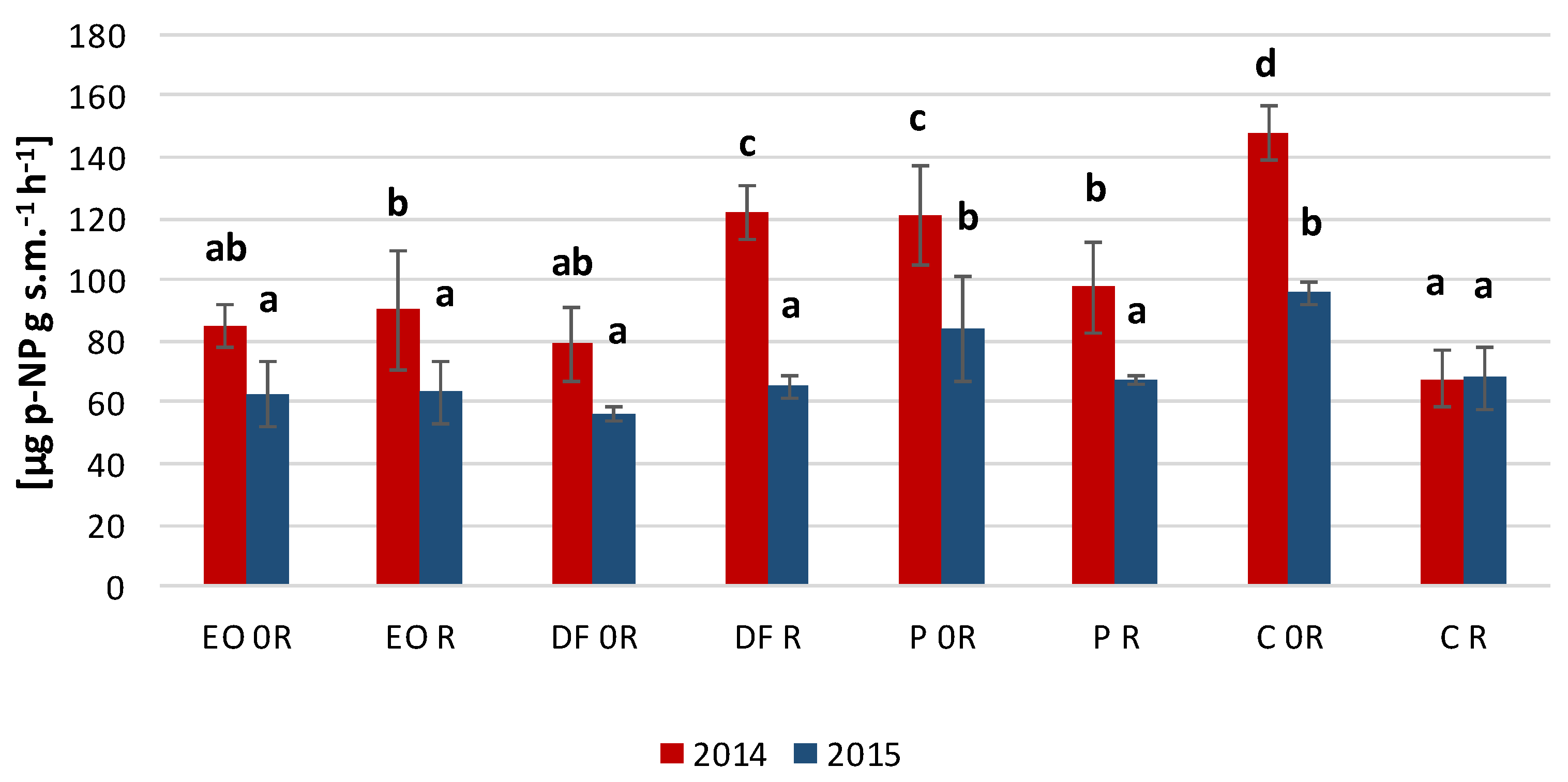
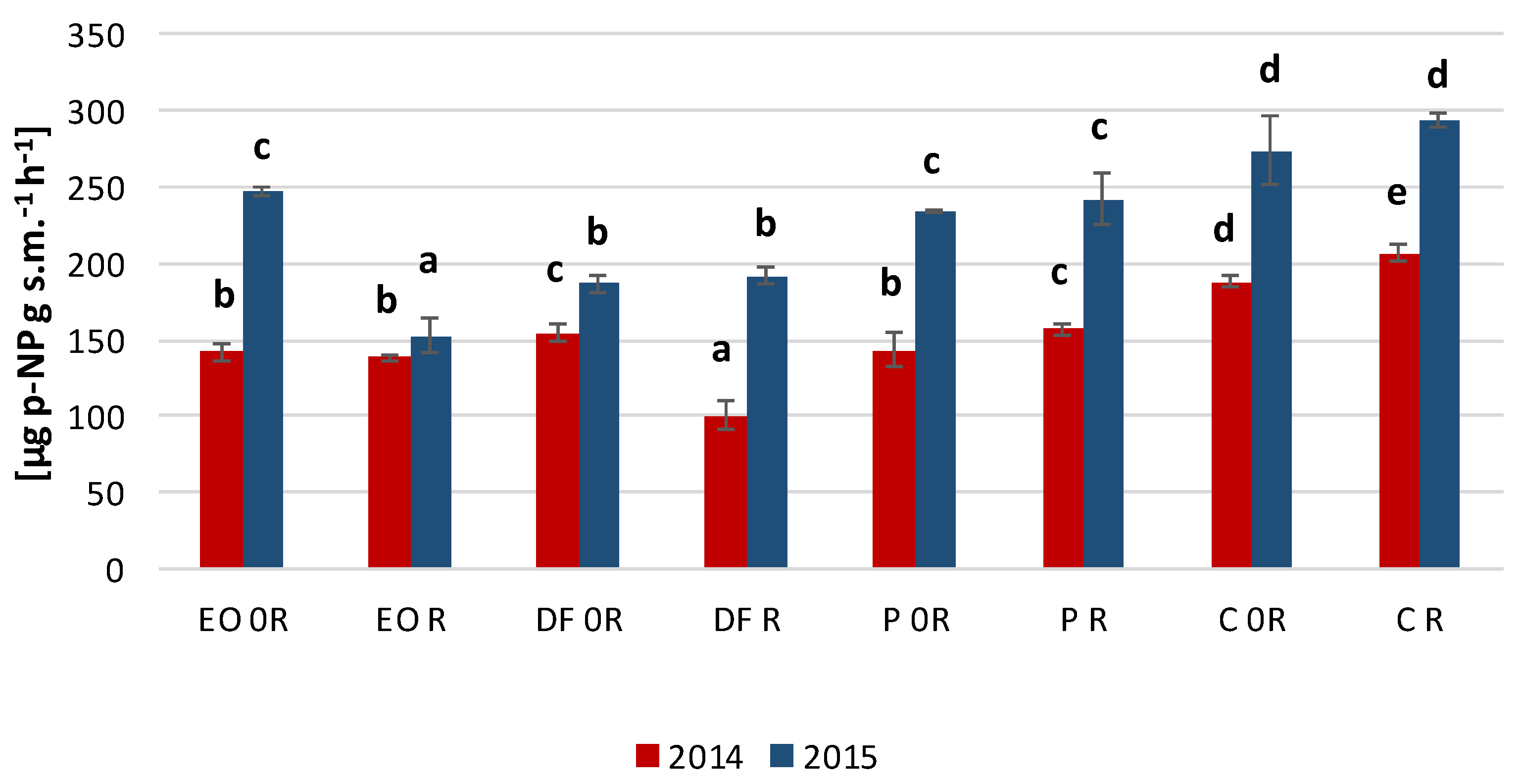
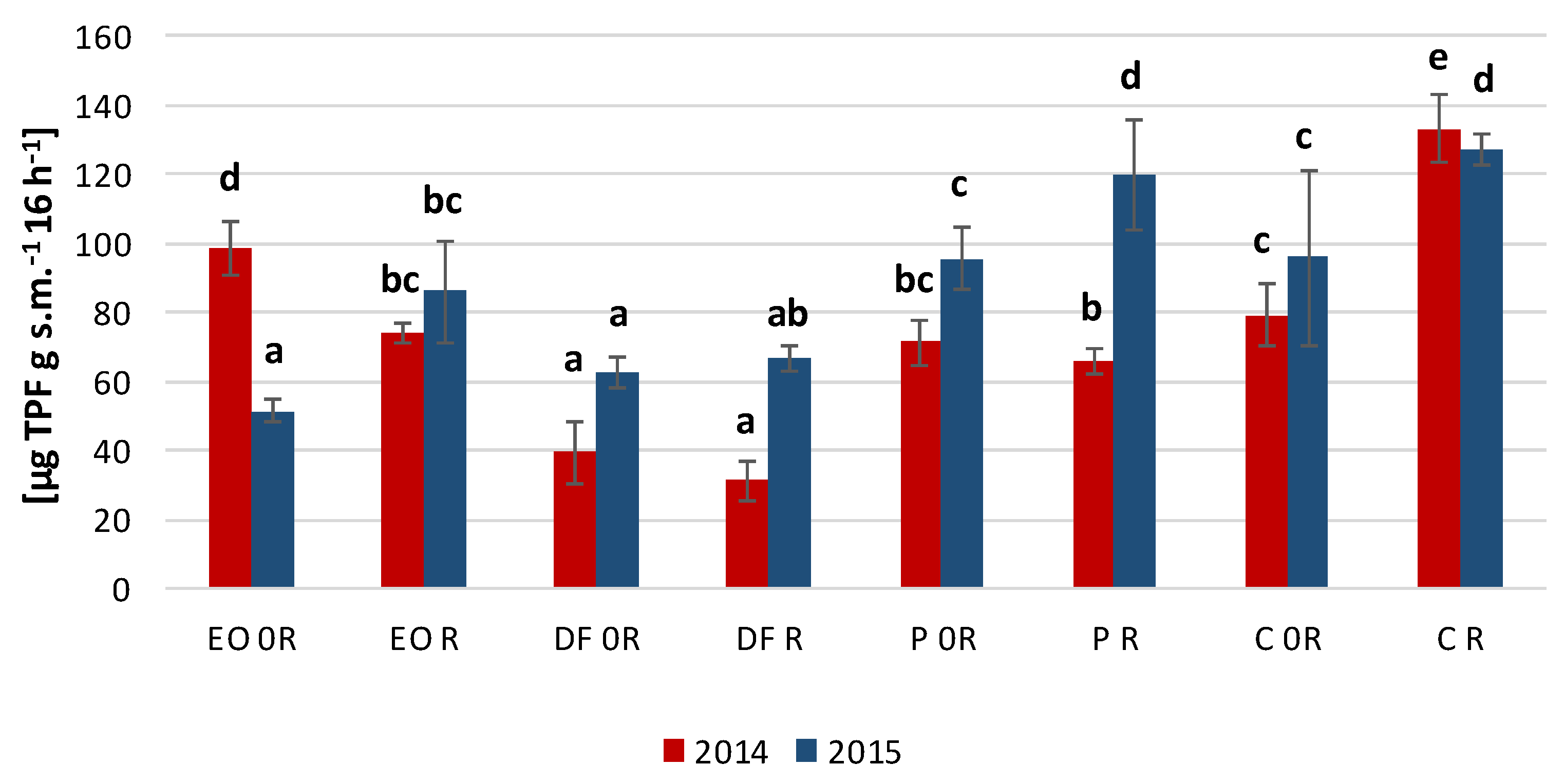
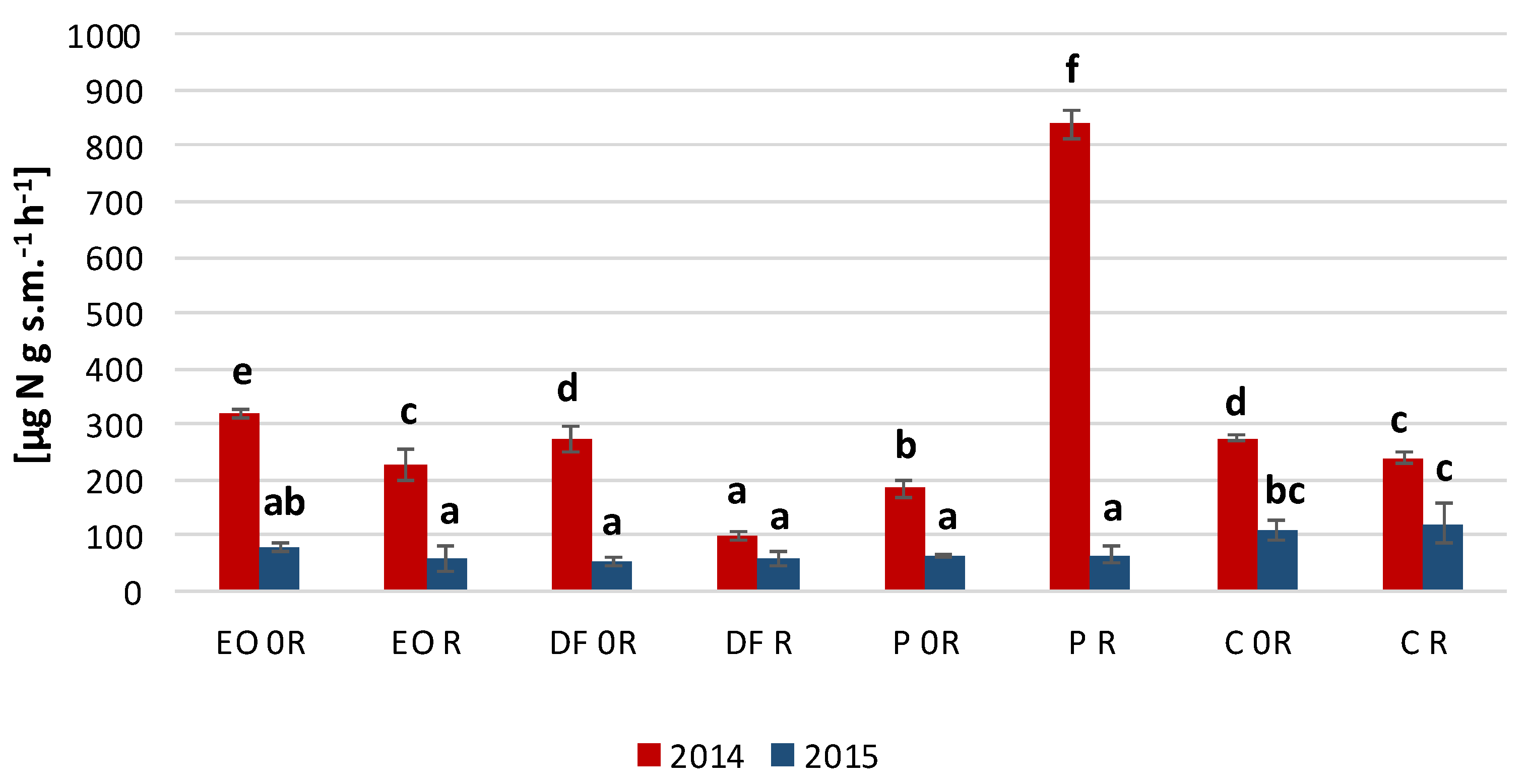

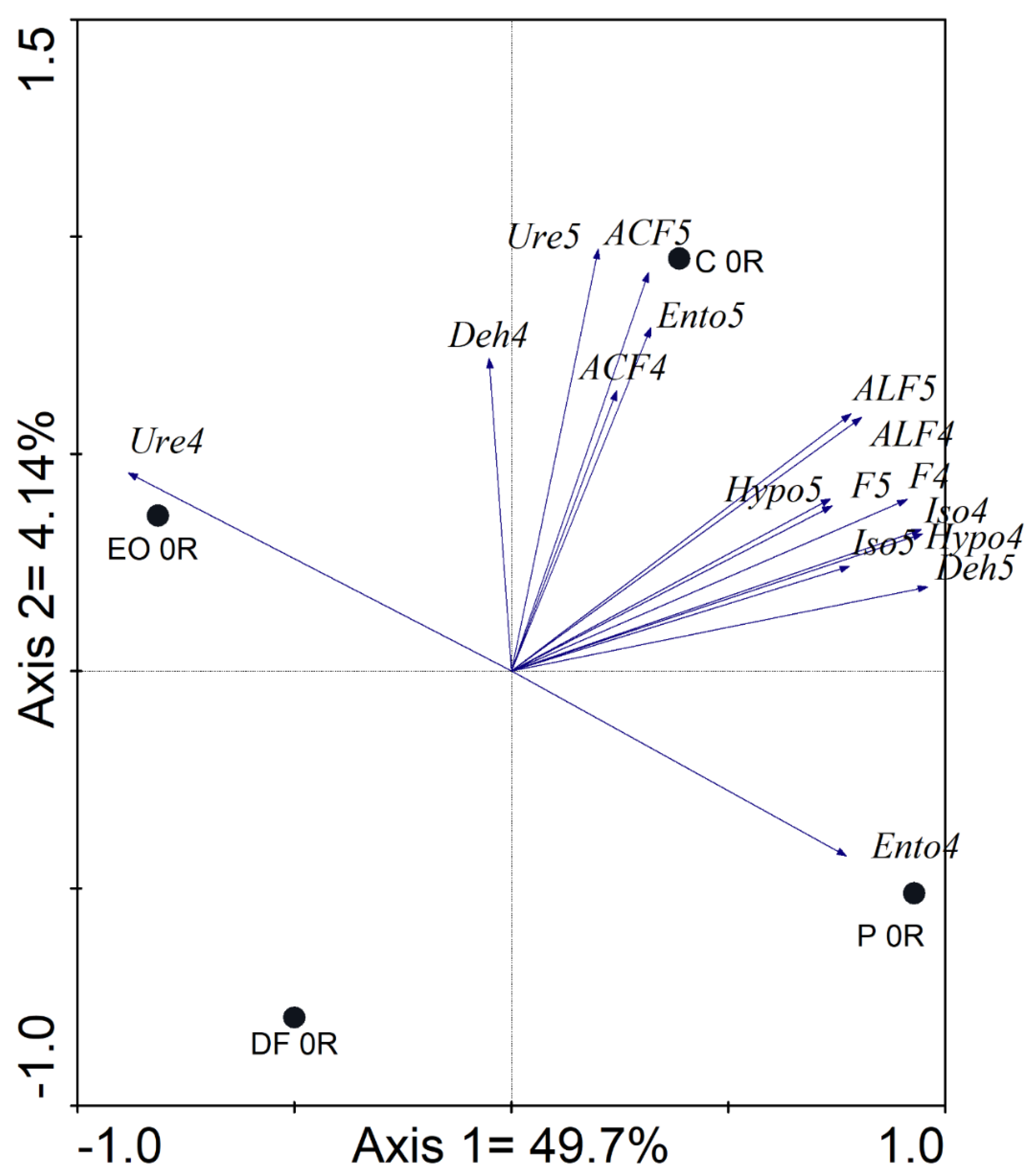
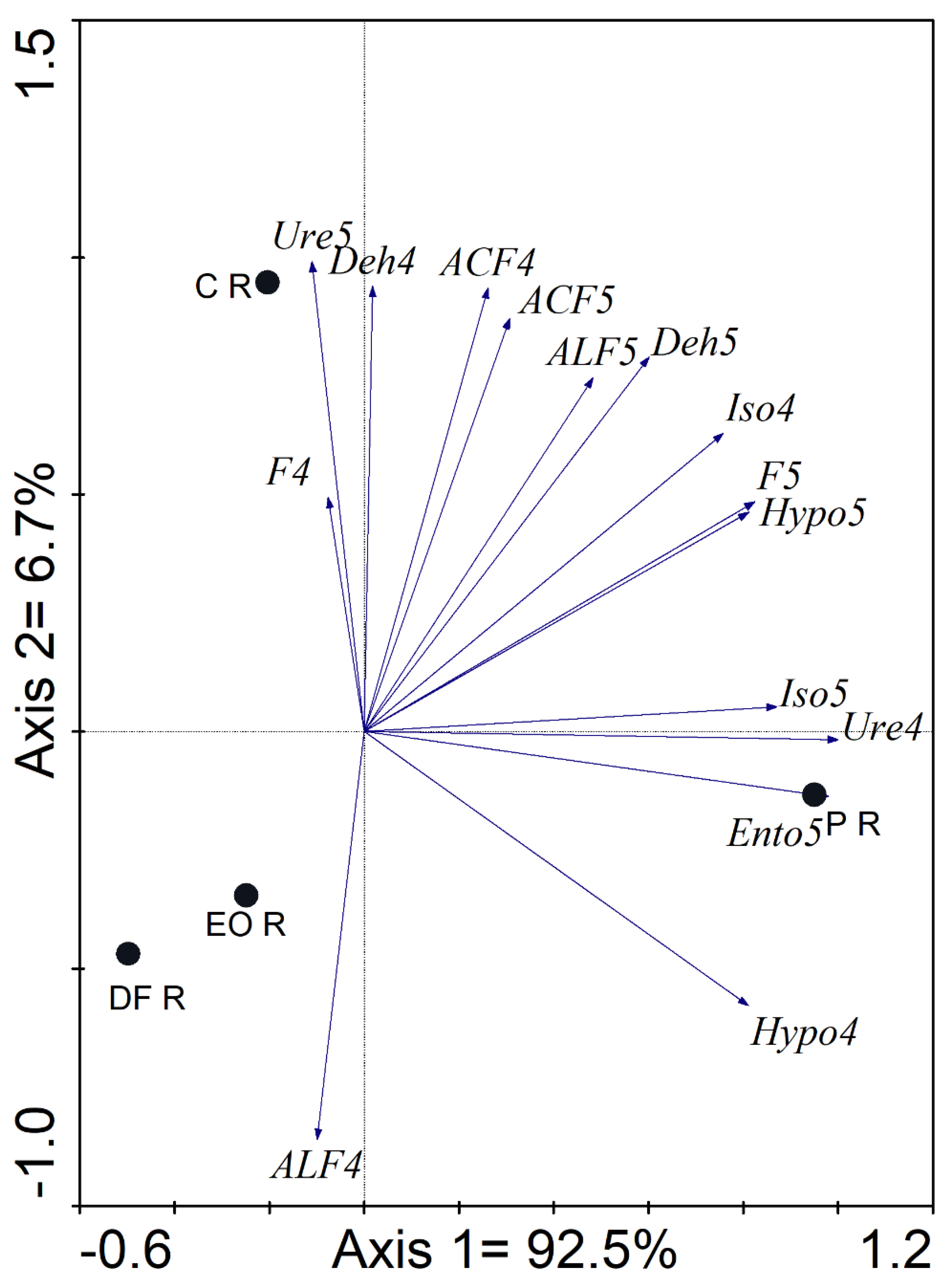
| Treatment | Alkaline Phosphatase | Acid Phosphatase | Dehydrogenase | Urease | ||||
|---|---|---|---|---|---|---|---|---|
| 2014 | 2015 | 2014 | 2015 | 2014 | 2015 | 2014 | 2015 | |
| EO 0R | −42.77 a* | −34.57 a | −24.45 c | −9.65 d | 24.28 d | −46.30 ab | 16.50 d | −27.61 b |
| EO R | 33.53 b | −6.70 b | −33.27 b | −47.91 a | −44.37 b | −32.60 b | −4.60 c | −51.63 a |
| DF 0R | −46.60 a | −41.41 a | −17.89 d | −31.95 b | −50.14 b | −34.51 ab | −0.02 c | −51.45 a |
| DF R | 80.08 c | −4.30 b | −51.50 a | −34.65 b | −76.65 a | −47.66 a | −58.04 a | −51.35 a |
| P 0R | −18.30 a | −12.46 b | −23.90 cd | −14.72 cd | −9.82 c | −0.23 c | −32.76 b | −40.45 ab |
| P R | 44.11 b | −1.0 b | −24.27 c | −17.65 c | −50.52 b | −5.98 c | 249.90 e | −46.05 a |
| Treatment | Soil Invertebrates | ||||
|---|---|---|---|---|---|
| Total | Enchytraeidae | Collembola | Nematoda | Arachnida | |
| 29.09 | |||||
| EO 0R | 1.0 (±0.0) a* | 0.0 (±0.0) a | 0.0 (±0.0) a | 1.0 (±0.0) ab | 0.0 (±0.0) a |
| EO R | 2.5 (±0.7) ab | 0.0 (±0.0) a | 0.5 (±0.7) ab | 0.0 (±0.0) a | 0.0 (±0.0) a |
| DF 0R | 1.0 (±0.7) a | 0.5 (±0.7) a | 0.0 (±0.0) a | 0.0 (±0.0) a | 0.0 (±0.0) a |
| DF R | 7.0 (±1.4) b | 0.0 (±0.0) a | 0.0 (±0.0) a | 1.5 (±0.7) b | 5.5 (±0.7) b |
| P 0R | 2.5 (±2.1) ab | 0.0 (±0.0) a | 2.0 (±1.4) b | 0.5 (±0.7) ab | 0.0 (±0.0) a |
| P R | 3.0 (±1.4) ab | 0.0 (±0.0) a | 1.5 (±0.7) ab | 1.0 (±0.0) ab | 0.5 (±0.7) a |
| C 0R | 3.0 (±1.4) ab | 0.5 (±0.7) a | 1.5 (±0.7) ab | 1.0 (±0.0) ab | 0.0 (±0.0) a |
| C R | 4.0 (±3.5) ab | 2.5 (±2.1) b | 0.0 (±0.0) a | 1.0 (±1.4) ab | 0.0 (±0.0) a |
| 18.11. | |||||
| EO 0R | 0.0 (±0.0) a | 0.0 (±0.0) a | 0.0 (±0.0) a | 0.0 (±0.0) a | 0.0 (±0.0) a |
| EO R | 1.5 (±0.7) ab | 0.5 (±0.7) a | 0.0 (±0.0) a | 0.5 (±0.7) a | 0.5 (±0.7) ab |
| DF 0R | 0.0 (±0.0) a | 0.0 (±0.0) a | 0.0 (±0.0) a | 0.0 (±0.0) a | 0.0 (±0.0) a |
| DF R | 1.0 (±0.0) ab | 0.0 (±0.0) a | 0.5 (±0.7) ab | 0.0 (±0.0) a | 0.5 (±0.7) ab |
| P 0R | 2.5 (±0.7) abc | 0.0 (±0.0) a | 0.5 (±0.7) ab | 1.0 (±0.0) a | 1.0 (±0.0) b |
| P R | 3.5 (±0.7) bc | 0.5 (±0.7) a | 2.0 (±1.4) b | 1.0 (±1.4) a | 0.0 (±0.0) a |
| C 0R | 3.0 (±1.4) bc | 0.0 (±0.0) a | 0.5 (±0.7) ab | 0.5 (±0.7) a | 1.0 (±0.0) b |
| C R | 4.5 (±2.1) c | 0.0 (±0.0) a | 1.5 (±0.7) ab | 1.0 (±1.4) a | 0.5 (±0.7) ab |
| Treatment | Soil Invertebrates | ||||
|---|---|---|---|---|---|
| Total | Enchytraeidae | Collembola | Nematoda | Arachnida | |
| 22.06. | |||||
| EO 0R | 1.0 (±0.0) a* | 0.0 (±0.0) a | 0.5 (±0.7) ab | 0.5 (±0.7) a | 0.0 (±0.0) a |
| EO R | 1.5 (±0.7) a | 1.5 (±0.7) b | 0.0 (±0.0) a | 0.0 (±0.0) a | 0.0 (±0.0) a |
| DF 0R | 4.0 (±2.8) a | 0.5 (±0.7) ab | 2.0 (±1.4) ab | 1.0 (±1.4) a | 0.5 (±0.7) ab |
| DF R | 1.0 (±0.7) a | 0.0 (±0.0) a | 0.5 (±0.7) ab | 0.0 (±0.0) a | 0.5 (±0.7) ab |
| P 0R | 5.5 (±3.5) a | 0.0 (±0.0) a | 3.5 (±3.5) ab | 1.5 (±0.7) a | 0.5 (±0.7) ab |
| P R | 9.5 (±3.5) ab | 0.0 (±0.0) a | 9.5 (±3.5) bc | 0.0 (±0.0) a | 0.0 (±0.0) a |
| C 0R | 17.5 (±9.1) b | 0.5 (±0.7) ab | 14.0 (±9.9) c | 1.0 (±0.0) a | 2.0 (±1.4) b |
| C R | 3.0 (±0.7) a | 0.5 (±0.7) ab | 0.5 (±0.7) ab | 0.5 (±0.7) a | 1.0 (±0.0) ab |
| 18.08. | |||||
| EO 0R | 0.5 (±0.7) a | 0.0 (±0.0) a | 0.0 (±0.0) a | 0.0 (±0.0) a | 0.0 (±0.0) a |
| EO R | 0.5 (±0.7) a | 0.0 (±0.0) a | 0.5 (±0.7) a | 0.0 (±0.0) a | 0.0 (±0.0) a |
| DF 0R | 1.0 (±0.0) ab | 0.0 (±0.0) a | 0.5 (±0.7) a | 0.0 (±0.0) a | 0.5 (±0.7) a |
| DF R | 0.5 (±0.7) a | 0.5 (±0.7) a | 0.0 (±0.0) a | 0.0 (±0.0) a | 0.0 (±0.0) a |
| P 0R | 4.0 (±2.8) abc | 0.0 (±0.0) a | 2.0 (±2.8) a | 0.0 (±0.0) a | 2.0 (±0.0) b |
| P R | 8.0 (±2.8) c | 0.0 (±0.0) a | 8.0 (±2.8) b | 0.0 (±0.0) a | 0.0 (±0.0) a |
| C 0R | 5.0 (±4.2) bc | 0.0 (±0.0) a | 3.0 (±2.8) a | 0.0 (±0.0) a | 0.5 (±0.7) a |
| C R | 4.0 (±1.4) abc | 0.5 (±0.7) a | 1.5 (±0.7) a | 0.5 (±0.7) a | 2.0 (±1.4) b |
| 06.10 | |||||
| EO 0R | 1.0 (±0.0) a | 0.5 (±0.7) a | 0.0 (±0.0) a | 0.0 (±0.0) a | 0.5 (±0.7) a |
| EO R | 1.0 (±1.4) a | 0.0 (±0.0) a | 1.0 (±1.4) ab | 0.0 (±0.0) a | 0.0 (±0.0) a |
| DF 0R | 1.5 (±0.7) a | 0.0 (±0.0) a | 0.5 (±0.7) a | 0.0 (±0.0) a | 1.0 (±1.4) a |
| DF R | 3.0 (±1.4) ab | 0.0 (±0.0) a | 3.0 (±1.4) ab | 0.0 (±0.0) a | 0.0 (±0.0) a |
| P 0R | 1.5 (±0.7) a | 0.0 (±0.0) a | 0.5 (±0.7) a | 0.0 (±0.0) a | 1.0 (±0.0) a |
| P R | 11.5 (±3.5) b | 1.5 (±2.1) a | 10.0 (±5.7) b | 0.0 (±0.0) a | 0.0 (±0.0) a |
| C 0R | 4.0 (±0.0) ab | 0.5 (±0.0) a | 3.0 (±0.0) ab | 0.0 (±0.0) a | 0.5 (±0.7) a |
| C R | 8.5 (±9.9) ab | 0.0 (±0.7) a | 8.0 (±9.9) ab | 0.0 (±0.0) a | 0.0 (±0.0) a |
| Treatment | Collembola Familiy | |||||
|---|---|---|---|---|---|---|
| Hypogastruidae | Isotomidae | Entomobryidae | ||||
| 2014 | 2015 | 2014 | 2015 | 2014 | 2015 | |
| EO 0R | 0.0 (±0.0) a* | 1.2 (±0.4) a | 0.0 (±0.0) a | 0.0 (±0.0) a | 0.0 (±0.0) a | 0.0 (±0.0) a |
| EO R | 1.3 (±0.5) a | 3.4 (±0.8) a | 0.0 (±0.0) a | 0.0 (±0.0) a | 0.0 (±0.0) a | 0.0 (±0.0) a |
| DF 0R | 0.0 (±0.0) a | 4.8 (±0.8) a | 0.0 (±0.0) a | 1.2 (±0.4) a | 0.0 (±0.0) a | 0.0 (±0.0) a |
| DF R | 1.3 (±0.5) a | 6.1 (±1.3) a | 0.0 (±0.0) a | 1.2 (±0.4) a | 0.0 (±0.0) a | 0.0 (±0.0) a |
| P 0R | 2.8 (±1.0) a | 9.6 (±2.0) a | 1.3 (±0.5) a | 2.3 (±0.5) ab | 1.3 (±0.5) a | 0.0 (±0.0) a |
| P R | 3.5 (±0.6) a | 40.8 (±2.4) b | 3.3 (±0.5) b | 8.5 (±0.8) c | 0.0 (±0.0) a | 4.8 (±1.0) b |
| C 0R | 2.8 (±0.5) a | 33.6 (±6.3) b | 1.3 (±0.5) a | 4.8 (±0.8) b | 0.0 (±0.0) a | 1.2 (±0.4) a |
| C R | 0.5 (±0.6) a | 19.2 (±5.3) ab | 2.3 (±0.5) a | 1.2 (±0.4) a | 0.0 (±0.0) a | 0.0 (±0.0) a |
Publisher’s Note: MDPI stays neutral with regard to jurisdictional claims in published maps and institutional affiliations. |
© 2021 by the authors. Licensee MDPI, Basel, Switzerland. This article is an open access article distributed under the terms and conditions of the Creative Commons Attribution (CC BY) license (http://creativecommons.org/licenses/by/4.0/).
Share and Cite
Gospodarek, J.; Rusin, M.; Barczyk, G.; Nadgórska-Socha, A. The Effect of Petroleum-Derived Substances and Their Bioremediation on Soil Enzymatic Activity and Soil Invertebrates. Agronomy 2021, 11, 80. https://doi.org/10.3390/agronomy11010080
Gospodarek J, Rusin M, Barczyk G, Nadgórska-Socha A. The Effect of Petroleum-Derived Substances and Their Bioremediation on Soil Enzymatic Activity and Soil Invertebrates. Agronomy. 2021; 11(1):80. https://doi.org/10.3390/agronomy11010080
Chicago/Turabian StyleGospodarek, Janina, Milena Rusin, Gabriela Barczyk, and Aleksandra Nadgórska-Socha. 2021. "The Effect of Petroleum-Derived Substances and Their Bioremediation on Soil Enzymatic Activity and Soil Invertebrates" Agronomy 11, no. 1: 80. https://doi.org/10.3390/agronomy11010080
APA StyleGospodarek, J., Rusin, M., Barczyk, G., & Nadgórska-Socha, A. (2021). The Effect of Petroleum-Derived Substances and Their Bioremediation on Soil Enzymatic Activity and Soil Invertebrates. Agronomy, 11(1), 80. https://doi.org/10.3390/agronomy11010080






